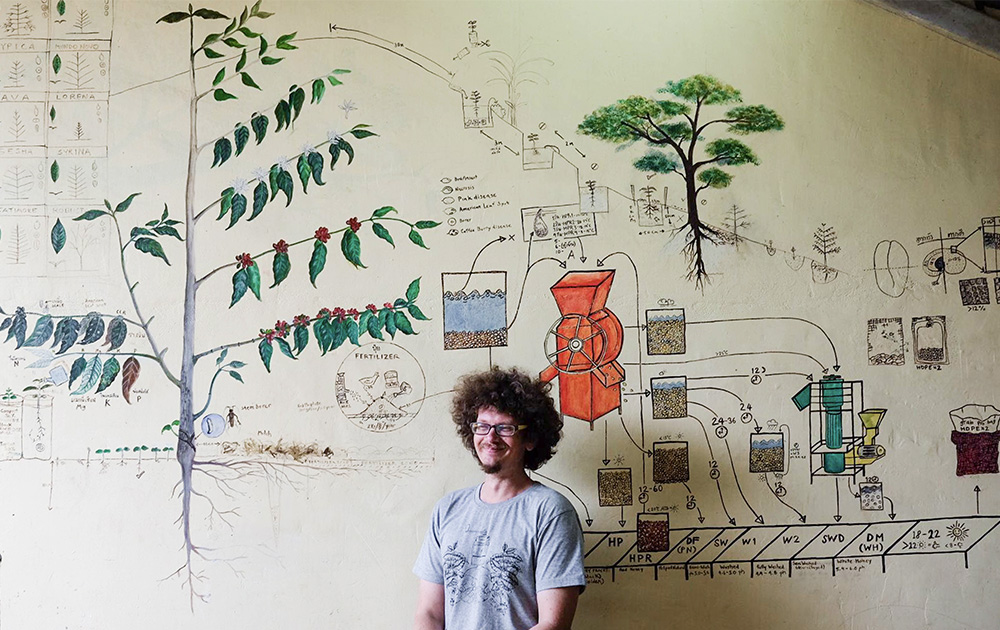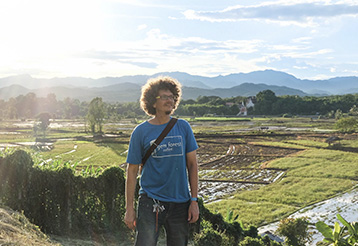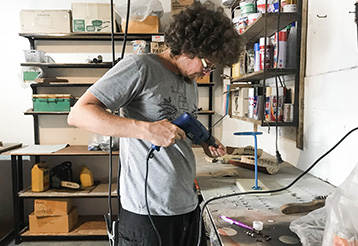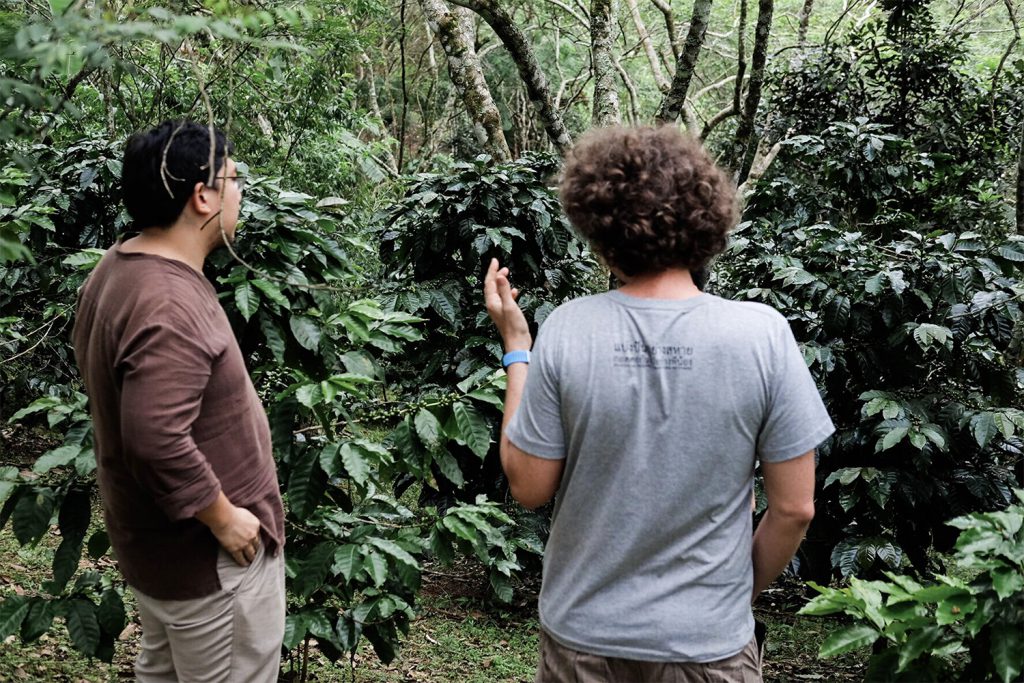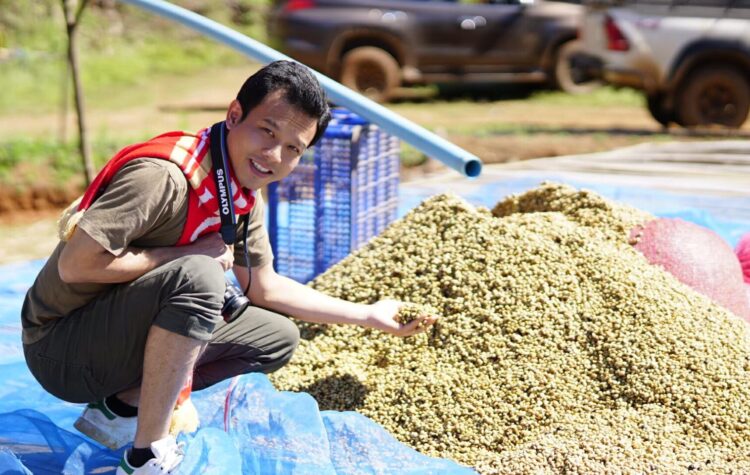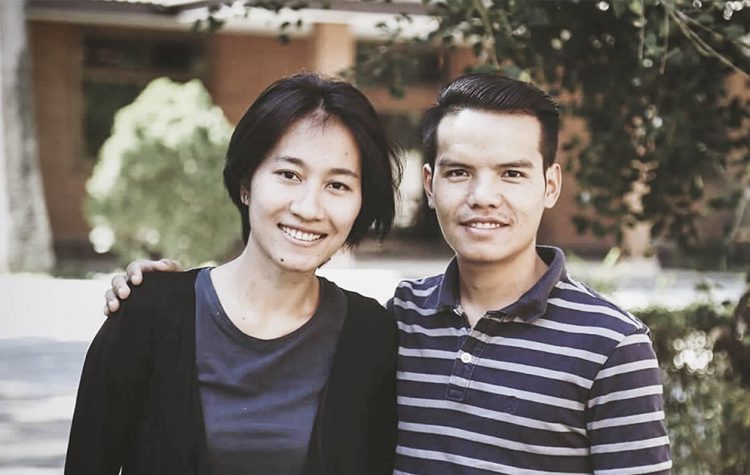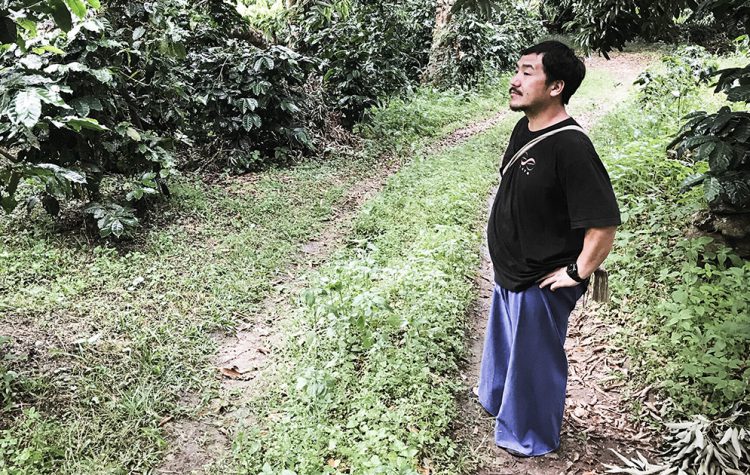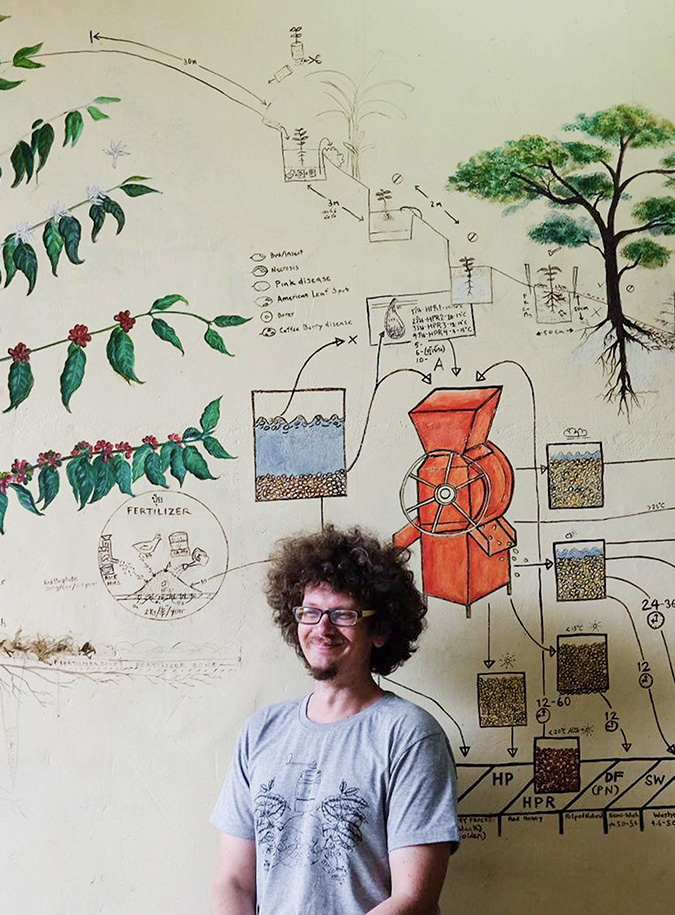
If you’ve been following the Thai coffee industry in the last year, you’ve almost certainly heard about Kaleb Jordan, or ‘P’ Kaleb’, a coffee producer and owner of Gem Forest Roastery from Doi Maneepruek. P’ Kaleb was the first person to introduce Nan to specialty coffee varieties like Geisha.
Despite his non-Thai appearance, P’ Kaleb identifies as 100% Thai due to his family’s missionary background. He grew up with Prai Villagers in Nan and went to attend University in the United States, where he worked at a Church Roastery while studying the bible. It was there that he developed an interest in the science of roasting coffee and saw an opportunity to use the power of coffee to improve the lives of the people in the village where he grew up.
P’ Kaleb has spent 17 years working with coffee and uses it as a tool to create sustainable careers for nearly 20 farmers in the northern coffee plantations. As a well-known coffee producer, it motivates him to focus on accomplishing more things. Let’s hear more about what he has to say.
Mr. Roots: What does Coffee mean to you?
P’ Kaleb: In my opinion, coffee is a tool that helps people. It is something that will improve the lives of villagers, provide them with opportunities, and allow them to work freely in the community. Coffee is a means of expressing love to those in the community.
A more personal response would be that I believe coffee is complex and sophisticated, and that no matter how much we know or study it, we can never fully comprehend it. When we learn something new, it sparks an interest in something else. I enjoy studying and experimenting, so coffee is a source of enjoyment for me because it allows me to think and try out new creative ideas, constantly challenging myself.
Mr. Roots: What are you focusing on this year?
P’ Kaleb: After listening to Lucia Solis’s podcast, I thought I’d give the Washed processing method a good try. It’s a method we’ve used for a long time, but I’ve always overlooked the details because from the surface it seems like a mediocre method. We’ve always experimented with new and creative processing methods, but there’s a lot more about the Washed processing method that I’d like to learn, particularly temperature control. This, I believe, will greatly improve my understanding of it.
The idea was to experiment with the Washed processing method while fermenting at different temperatures using natural microbial fermentation and coffee fermentation with yeast to see how these variables affect the taste. If we can conclude our findings at the beginning of the coffee season, I will use this method to make a large batch of Washed coffee for the middle to end of the season.
Mr. Roots: You support coffee cherries from so many sources, do you have a goal to find or develop new coffee plantations as well?
P’ Kaleb: Yes I do, I recently spoke to a friend from Mae Sariang in Mae Hong Son about establishing a Mill there and helping each other with coffee processing, and we can apply what we learned from our experiments at Maneepruek Village as well. Mae Sariang is a region that has been producing coffee for such a long time; there’s a well-known coffee area called Baan Huai Hom, and there are many other villages that are less well-known yet produce great coffee. Take, for example, a place called Baan Mae Hoh, whose coffee reminded me of Maneepreuk Village the first time I had it. The landscape is also similar, with hills, fogs, and cool temperatures, but the farmers use the Washed method in a casual manner, with little regard for details. I believe that if there was someone there to guide them, pay attention to the details, and teach them new processing techniques to improve their coffee, a place like this could produce excellent coffee.
Mr. Roots: What are your principles for selecting coffee cherries from various sources and determining which processing technique to use?
P’ Kaleb: I believe that coffee from every source is suitable for any process; there is no “optimal process” for a certain type of coffee, so the processing method chosen is mostly determined by the weather conditions in that area. Villages with a lot of rain, fog, and little sun, for example, are more suited to Washed processed than Natural, because if the coffee cherries aren’t dried properly, they can get moldy. Villages that see a lot of sunlight on the other hand, will focus on Natural and Honey Process. However, just because the village has a lot of fog doesn’t mean you can’t process it the Natural way. In Maneepruek, for example, I tried to fix this problem by building an LTLH (Low Temperature Low Humidity) room to dry the coffee. So we can still dry the coffee despite the fog.
Mr. Roots: Since experimenting with processing methods, is there a method that you felt completely changed your way of thinking?
P’ Kaleb: I think it was roughly 6-7 years ago that I believed coffee from Maneepruek Village was enough to go to the specialty coffee market, so I experimented with processing methods with just Maneepruek coffee. We acquired coffee from a variety of other sources at the same time period, one of which was Doi Phu Kha. They were having difficulty entering the market since someone had suggested they grow this coffee and then disappeared without returning to buy it, and they called me to ask if there was a channel or means to sell it. As a result, I brought their coffee in as an alternative for customers, selling it as a Washed processed, dark roast, and brewing it as a standard espresso.
After I processed Maneepruek’s coffee for 2-3 years with Red Honey, I thought we could try it with some other Doi coffees as well. So, I started processing Doi Phu Kha coffee with Red Honey and the results were outstanding. Previously, I didn’t think that this coffee could be elevated to a special level, but this experience has changed my view, and I now believe that coffee from other sources can be delicious as well. Following that year, I primarily processed Doi Phu Kha coffee with Red Honey.
Mr. Roots: Coffee has helped people get to know you better, and you already have a loyal customer base; do you want to build on these successes to do something else later?
P’ Kaleb: That’s a great question, but I’m not sure I have a great answer for you (laughs). Working at the Roastery these days, I don’t think too far ahead because we’re just trying to get by each week. However, I believe that the more people are interested in trying out new coffees that we launch, the better opportunity we have to get to know our customers. It’s as if we’re inviting everyone to come learn about coffee with us, and, more significantly, it’s motivating for us as coffee processors because it encourages us to source coffee cherries from different regions, which benefits everyone.
Mr. Roots: Why do you believe that sourcing coffee cherries from farmers who are in trouble is one of your duties?
P’ Kaleb: When you look at it from the farmer’s point of view, their goal is to sell coffee. If their coffee doesn’t sell or if they believe no one wants to buy it, it’s a troubling and unpleasant feeling. So, if I have the financial means, I will always want to support them by buying their coffee to sell to my customers. Last year, I bought all of the coffee cherries that people offered me and didn’t say no to anyone, but it turned out that I bought too many and there are coffee cherries left in the warehouse (laughs), so I’ll have to learn to say no this year, but I still hope to buy from everyone.





